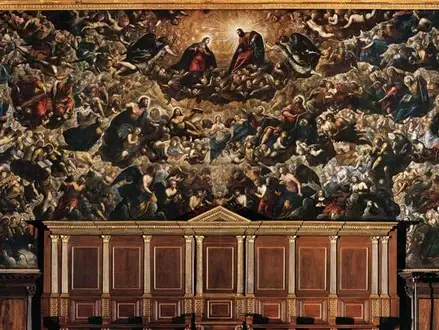Title of Artwork: “Paradise”

Artwork by Tintoretto
Year Created 1592
Summary of Paradise
At the Doge’s Palace in Venice, Italy, a fire started on the ground floor in December of 1577. The fire caused a lot of damage to the rooms’ decorations, walls, ceilings, and furniture, and it also changed the structure of the building. So much damage had been done that the idea of tearing down the old Gothic building and replacing it with a new one was seriously thought about by people.
All About Paradise
After a lot of debate, it was decided to repair the areas that had been damaged and to change the decor in the rest of the house, too. One of the rooms that was damaged was the Sala del Maggior Consiglio, which is one of the most well-known places in the city.
When the Great Council met in this large room, its size and grandeur made it one of the most majestic and imposing places in the whole place. Over 1,000 Venetian senators made up the Council in the 16th century, and they made up more than half the group. The room was used to pass laws and elect members of the magistracy.
Flat ceiling sections with decorative, high-relief moulding would be added to the room to make it look like it had been renovated. Paintings would then be put in these sections. Exactly the same idea was to be used for the frieze that ran along both of the long side walls of the room, where painted portraits of the Doges would be placed.
The Glorification of Venice was chosen as the theme for the walls of the room. It was shown through a series of military scenes. There would be three big canvases on the ceiling that would be the main parts of the ceiling.
They are a rectangular one by Jacopo Tintoretto, which shows the City of Venice giving a laurel wreath to Doge Nicol da Ponte in 1584, and two oval ones by Veronese and Palma Giovane show Venice, crowned by victory, receiving the conquered provinces from the Doge (1584).
If you want to replace an old painting made by Guariento around 1365 because it had been damaged in an arson attack, a competition was held. It may have been held in 1582, but it isn’t clear for sure. People who are blessed live in paradise, and this new picture shows them in their glory.
Francesco Bassano, Veronese, Palma Giovane, and Tintoretto were some of the artists who took part in this event. Veronese and Francesco Bassano, two artists who have very different styles, were chosen to work on the project. However, Veronese died in 1588, and Bassano hadn’t started his part by the time Veronese died. Tintoretto, who was seventy years old by this time, was given the project.
It had to be based on Dante’s “Paradise,” according to the rules for the competition. Clouds, angels, and cherubim all had different religious ranks, but Tintoretto made sure to include them all in the painting. It has a lot of different parts, but the main thing is that the Virgin is crowned in the upper centre.
The Dove of the Holy Spirit is the axis of this complicated piece. There are a lot of heads and figures in the background. The main group, with Christ leaning forward and reaching out to crown his mother, is in the middle. Among the clouds and stars, the rest of the figures in the painting are arranged in lines that gently curve.
There is an angel who tells Mary that she will give birth to a son or daughter called Jesus and there is also the Last Judgment. Tintoretto used symbols like scales to show these two things at once. It looks like ripples in a pond when the clouds wrap around the main figures. This is a good way to show how the church’s teachings still have an effect on people today.
At first glance, Paradiso looks like a picture of light and colour that aren’t very real. An intensely rendered figure in the work shows the artist’s skill at making sharp contrasts between light and dark. During the Baroque period, Tintoretto’s scene was dramatic and almost theatrical, setting the stage for this style of art.
Information Citations
En.wikipedia.org, https://en.wikipedia.org/.























